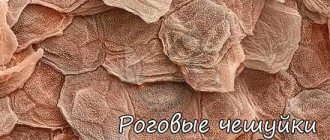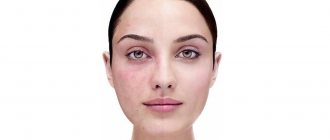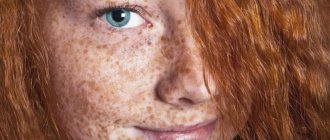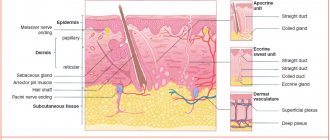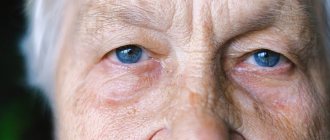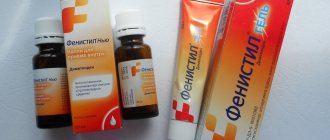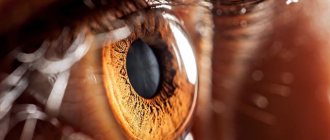Peeling of the skin represents an accelerated process of necrosis of body surface cells with their exfoliation, which significantly worsens the appearance of the skin, disrupting the natural balance of tissue regeneration. Due to the influence of many reasons, such changes are observed, contributing to excessive drying of the surface and active rejection of epithelial cells.
The visual characteristics of peeling represent the presence of small scales of the epidermis in certain areas of the skin, which manifests itself regardless of the type of skin, be it oily or combination. But most often people with dry skin suffer from such symptoms, when the root cause of peeling is genetically determined.
Make an appointment with a dermatologist by phone or by filling out the online form
| Select a clinic | Rash on back | Rash on cheeks | Rash on elbows |
Why does skin peeling occur?
A disruption in the natural balance of renewal of the cellular structures of the skin can be observed for a number of reasons, the impact of which provokes a pathological deviation. Among them, the following should be highlighted:
- changes in ambient temperature;
- manifestation of an allergic reaction to the external use of care products;
- existing skin diseases;
- unbalanced diet, which is associated with the lack of fat-soluble vitamins necessary for the skin;
- natural aging of the surface layer;
- hereditary predisposition.
Thus, the causal effect contributes to a change in the ratio of the rate of keratinization of epithelial cells with their rejection, which leads to the manifestation of typical signs of skin peeling:
- itching;
- change in skin turgor;
- the appearance of a hint of hyperemia;
- presence of relative pain syndrome;
- formation of small cracks on the surface.
The principle of combating the manifestations of peeling
In certain cases, the appearance of pathological detachment of the epidermal layer develops against the background of the following diseases, which require specific treatment to eliminate the cause of the development of the pathology, and as a result, peeling of the skin disappears:
- seborrheic skin lesions;
- psoriasis;
- systemic lupus erythematosus;
- ichthyosis;
- dry erythema;
- ringworm and its varieties;
- scarlet fever;
- skin damage due to fungal infection and other conditions.
The development of pathology can be stopped on your own by using appropriate products for local application, maximally nourishing and moisturizing areas of the skin that are subject to the process of active exfoliation. In case of nutritional disorders, additional intake of fat-soluble vitamins helps restore the natural balance of cell layer renewal.
But if the condition worsens or the cause of the signs of pathology is unclear, you should consult a dermatologist who will competently conduct a diagnostic examination, which will help determine the most appropriate course of treatment. The main goal of diagnostics in this case is to exclude the presence of an infectious pathogen of any kind, which requires the subsequent use of specific treatment.
Useful information on the topic:
- Calling a dermatologist to your home
- Fungal infections
- Rash on the body
- Sexually transmitted diseases
- How to get tested
- Wart removal
- Removal of condylomas
- Tests for STIs
- Removal of papillomas
- Skin rash
- Pyoderma
- Skin structure
- Mushroom tests
- Diagnosis of sexually transmitted infections
What diseases cause skin peeling?
There are many reasons that cause peeling skin. These include both ordinary allergies and more complex skin diseases. Dermatological diseases can be infectious or non-infectious. These include:
- Hereditary disease ichthyosis;
- Diseases of internal organs;
- Psoriasis;
- Dermatitis manifested in seborrhea;
- Lupus erythematosus;
- Fungal diseases of an infectious nature;
- Syphilis in secondary manifestations;
- Pityriasis rosea;
- Scarlet fever;
- Dry erytherma;
- Mycosis and xerosis.
With ichthyosis, the skin has a characteristic grayish tint. Its surface is covered with small scales. The patient experiences discomfort. His skin is peeling and itching. For this disease, no chemicals should be used. Even regular soap causes redness and irritation.
The main causes are sunburn, infections, HIV problems, dry skin in psoriasis, and skin injuries. Medicines play an important role. Seborrheic dermatitis occurs as a consequence of changes in the functioning of the skin. Sebum will be released in large quantities. This leads to progression of the disease.
Pityriasis rosea appears due to low levels of the body's immunity. This may be hypothermia of the dermis, insufficient nutrients. A cold or flu also worsens the condition of the body. It begins to react sensitively to external irritants in the form of soap, lotions, and other cosmetics. Cold wind, frost or hot weather increase pain.
Secondary syphilis appears as a skin rash. These invisible spots cause general malaise. The patient has a headache and a fever. Lymph nodes become larger. Peeling occurs suddenly. The deep layers need moisture. No amount of cosmetics can correct the situation. Treatment measures will give results if we find out the exact cause.
What is itchy skin like?
Itching of the skin can be of various types:
- Physiological and pathological itching. In the first case, the skin may itch due to some mechanical or chemical irritants, as well as insect bites. Pathological itching is a sign of a skin disease or other pathological condition, for example, neurological disorders or hormonal imbalance;
- Localized and generalized itching. Itching can be localized in a specific place, for example, under the hair on the head, in the genital area or anus, etc. As a rule, the symptom is paroxysmal in nature, often combined with other pathological manifestations of a particular disease. We are talking about generalized itching when literally the whole body itches. Often the symptom is associated with an allergic reaction or dry skin caused by dysfunction of the sebaceous glands;
- Constant and paroxysmal itching. With constant itching, the symptom persists throughout the day, its intensity may increase at a specific time of day, often in the evening. Paroxysmal itching appears independently or under the influence of certain irritating factors.
What tests need to be taken for peeling skin?
Deterioration of the condition of the skin can occur as a result of the use of bad cosmetics. In this case, it is enough to change your skin care system. But if the reasons are deep-rooted, then you must undergo a series of tests:
- General blood test. Necessary for identifying problems of an infectious nature, vitamin deficiency and anemia. This type of diagnosis allows you to identify helminths. They have a toxic effect on the body. This leads to deterioration of the dermis;
- Complete (biochemical) blood test. Its results make it possible to identify disturbances in the functioning of internal organs. You can find out what elements the body lacks for full development. For example, vitamins A and B affect skin condition. Their lack leads to flaking and dryness. Poor functioning of the kidneys, liver, stomach and all parts of the gastrointestinal tract also negatively affects our face, chin and other areas of the body.
- Blood test for general immunity level and determination of allergic reactions. A good allergy test can accurately find a specific allergen;
- Mycological examination. Prescribed to identify fungal infections in seborrheic dermatitis and pityriasis rosea;
- Histological examination. A scraping of the skin is taken in advance.
If a patient is suspected of having hormonal disorders, the doctor will refer you for a consultation with an endocrinologist. This specialist will determine the lack of hormones by ordering tests to determine thyroid hormones, estrogens (in women), and DHEA. With such an extensive examination, all causative factors can be determined. Draw up the correct treatment regimen. Develop a number of preventive recommendations.
Main sources of peeling
Regardless of whether the victim is faced with the problem around the mouth or on the fingers, he will first need to make an appointment with a cosmetologist or even a dermatologist. Otherwise, local therapy, which simply includes a cream, some lotions with decoctions of medicinal herbs, will be ineffective.
This is explained by the fact that in many victims, dryness along with necrosis of the epidermis does not appear at all due to the influence of harmful detergents and cleaning products. They are carriers of the ichthyosis gene, which manifests itself in the child at an early age. Pathology of a dermatological nature is often mistaken for traditionally dry skin.
In fact, ichthyosis is inherited, representing severe peeling, which occurs an order of magnitude more intensely than in those who did not receive the problematic gene. In addition to the fact that in men and women the torso is covered with a layer similar to artificial snow, the affected areas also periodically itch unbearably.
With such symptoms, only an experienced doctor can help get rid of the disease. Otherwise, the situation that has been ignored for years will get out of control, turning the body gray and white. The top layer is covered with small scales, which have a different color palette: from pearlescent to distinctly pink. In this situation, not a single mask or ointment made “according to grandma’s recipe” will help.
Difficulties are added by the fact that such staining with spots progresses constantly, only the localization of the new focus of inflammation changes. As soon as the slightest negative impact is exerted on the irritated area, the inflammation mechanism starts again. Against this background, many victims simply do not know what to do and how to remove unattractive manifestations at home, because even ordinary soap can provoke an exacerbation.
No less often, other dermatological diseases are the culprits of the abundant separation of superficial cells:
- seborrhea;
- psoriasis;
- pityriasis rosea;
- systemic lupus erythematosus;
- dry erythema.
There are cases in medical practice when the skin near the eye, on the eyelids, elbows, nose, and palms is affected by a fungus that is diagnosed even in newborns. But adults are more often affected by the consequences of destabilization of chronic internal organs, possibly secondary syphilis.
The huge family of various dermatitis, which includes three main categories, deserves special attention:
- atopic;
- contact;
- allergic.
All of these diseases result in the victim having to fight against excessive formation and subsequent accumulation of dead skin cells, which ends in traditional peeling.
If during the examination it turns out that the catalysts for deterioration of well-being are not cosmetics, but systemic ailments cause irritation, then therapy should be comprehensive. This means that you will first need to eliminate the lesion itself, and only then develop a treatment regimen for skin defects. Without detailed laboratory diagnostics, it is impossible to determine the treatment of the deviation.
Among the external influence factors, the most common culprits of peeling of the lips and other parts of the body are:
- alcohol-based skin care products;
- excessive passion for peeling;
- prolonged exposure to direct sunlight, as well as overdoing it with a solarium;
- shower gels and shampoos inappropriate for skin type.
In second place is vitamin deficiency, which is equally common in women, infants, and representatives of the stronger sex. Here, the root of the problem should be sought in an acute lack of vitamin A. In addition to the fact that the lack of such a vital element in sufficient quantities leads to peeling in the groin and chin, its deficiency often provokes dryness of the eye shell. In advanced cases, the clinical picture is supplemented by pustular rashes, especially in children with weakened immune systems.
According to some studies, a lack of vitamin B2 also negatively affects the appearance of the skin, especially visible on the forehead, near the wings of the nose, on the cheeks, in or near the ears. Additional markers are the acquired purple tint of the tongue, as well as small cracks in the corners of the mouth, which no oil softens.
No less often, abnormalities of this kind on the eyebrows, feet, and between the legs cause various hormonal disorders. Most often, the general condition is disrupted by an imbalance of female sex hormones or thyroid hormones. Taken together or individually, this leads to a significant decrease in natural elasticity, even if the victim initially had oily skin. The most striking example of such a disorder is hypothyroidism, a disease in which the level of production of thyroid hormones is significantly reduced.
The situation is even worse for women during menopause, when, along with dry feet, more wrinkles appear, as well as sagging skin, which is no longer masked by scrubs and creams.
What diet is necessary for peeling skin?
Balanced hypoallergenic diets will help fight the disease. First of all, you need to identify those products that cause painful reactions. Eliminate chocolate candies and bars from your daily diet. Citrus fruits, raspberries, strawberries, pomegranate, melon, black currants can also cause dryness. Honey, fish, nuts, mushrooms, cocoa, caviar are included in the list of such products.
Salads seasoned with vegetable oil have a healing effect. You should include porridge, eggs, dairy products, carrots, tomatoes, liver, and seeds. These products help increase the level of vitamins A and E. The lack of vitamin B can be compensated by unrefined cereals, green vegetables, avocados, bananas, carrots, walnuts, and cod fish liver.
Home remedies to combat peeling skin of the face and body
It is also possible to cope with peeling at home if it is caused by a lack of skin care. To do this, you can use masks based on natural moisturizing ingredients: vegetable oils, dairy products, honey, flax grains and others. Before applying the mask, it is recommended to do a light exfoliation with a scrub to remove some of the dead particles of the epidermis. It’s easy to prepare it yourself by mixing natural medium-ground coffee with honey or olive oil.
Peeling should be avoided if the skin on the face has cracks and inflammation caused by excessive dryness.
Face and body masks based on vegetable oils
Heat 100 ml of any olive or flaxseed oil to body temperature, add 6 drops of liquid vitamins A and E, which can be purchased at the pharmacy. Soak a cotton sponge in the solution and wipe the flaky skin with it, paying special attention to the forehead, chin, nose, and area around the lips. Repeat the procedure several times every 5 minutes. Leave the mask on your face, avoiding the eye area, or on your body for half an hour, then rinse with warm water and remove excess moisture and oils by patting your skin with a soft cloth.
Combine 1 teaspoon each of olive oil, natural honey and aloe pulp, mix thoroughly and spread the resulting mixture on your face, leaving for at least 15 minutes. Then rinse with warm water. The same mask can also be used to eliminate peeling on the fingers, feet, and other parts of the body, only the ingredients must be mixed in larger quantities in the same proportions.
When using masks made from natural ingredients, it is important to first make sure that you are not allergic to any of them.
Anti-flaking masks based on dairy products
Heat homemade yogurt, sour cream or full-fat kefir to room temperature and mix with oatmeal crushed in a blender in a 1:1 ratio. Add a few drops of flaxseed oil and leave for 10 minutes. Then apply the resulting paste to the skin, leaving for half an hour.
To use a milk-egg mask, which will perfectly soften and moisturize the skin, combine 1 raw egg and a couple of spoons of natural fat yogurt or curdled milk until smooth. Apply to the skin in several steps and leave for 20 minutes, then rinse with warm water.
Flax seed mask
Flax seed is a real storehouse of nutrients and an excellent natural moisturizer. This ingredient is indispensable for problems with the epidermis associated with dryness and flaking. To create a mask, you need to pour 1 teaspoon of seeds into 100 ml of boiling water, stir thoroughly, and leave for several hours. The resulting viscous liquid then needs to be applied to the skin with a cotton pad in 4-5 steps, allowing the previous layer to dry a little, and leave for 20 minutes.
Peeling of the skin due to gastrointestinal diseases
Painful signs associated with disturbances in the functioning of the gastrointestinal tract are immediately reflected in the condition of the skin:
- Gastritis and stomach ulcers cause acne, unnatural skin color, acne scars, greasy or dry skin;
- Diabetes, pancreatitis lead to itching, dryness, allergic reactions;
- Hepatitis and liver pathologies become the causes of the formation of age spots, jaundice, pimples, blackheads, asterisks, furunculosis;
- Gallbladder diseases contribute to the development of pimples, blackheads, jaundice, age spots;
- Duodenal ulcers, dysfunctions of the small intestine manifest themselves in unhealthy complexion, pimples, acne, allergic disorders, sagging, dryness;
- Constipation, diarrhea, disturbances in the functioning of the large intestine lead to fungal infections, sagging, dryness, acne, pimples and allergic spots.
If painful changes are detected, you should reconsider your diet. Consult a doctor for help, create an individual digestive program.
Common symptoms and manipulations in dermatology:
- Skin rashes
- Calling a dermatologist to your home
- Itching in the urethra
- Itchy skin
- Skin rash
- Prevention of casual sex
- Skin neoplasms
- Pyoderma
- Pityriasis rosea
- Streptoderma
- Scabies
- Peeling skin
- Fungal infections
- Skin infection
- Pus on the skin
- Blisters on the skin
- Papillomas on the foreskin
- Sexually transmitted diseases
- Skin structure
A balanced diet as a means of combating flaking
In many cases, the occurrence of peeling of the skin is directly or indirectly associated with an imbalance in the body of nutrients, vitamins and minerals. Thus, the active separation of keratinized epidermis can be triggered by a lack of protein or healthy unsaturated fats, retinol, vitamins E and PP. That’s why it’s important to analyze your diet and make it complete: include as much fatty sea fish, avocados, nuts and herbs in your diet as possible, consume natural vegetable oils, bran, and apples. Carrots, beef liver or cottage cheese will help replenish vitamin A.
If you need to quickly solve the problem of flaking caused by a lack of nutrients, it is better to start taking vitamins and omega-3 and omega-6 polyunsaturated fatty acids contained in capsules.
Plain water has a direct effect on skin hydration. Its deficiency in the body gradually changes the condition of the epidermis, leading to dryness and flaking. That is why daily consumption of 1.5 to 2 liters of purified water can be an additional means of combating these ailments. This amount should be spread out throughout the day so that the liquid is maximally absorbed by the body and not simply excreted by the kidneys after a single dose.
Peeling skin in children
The thickness of the top layer of skin in children is less than in adults. And therefore the causes of dryness are much greater:
- Prolonged exposure to the sun;
- Cold wind currents;
- Negative effects of soaps, shampoos and other care products;
- Lack of vitamins;
- Constant nervous disorders and stress;
- Infectious problems.
Children often experience chamomile, lichen, fungal infections, dermatitis, and eczema. Cases of hereditary diseases cannot be excluded.
All this is a consequence of poor nutrition and hygiene procedures based on low-quality products. Only a specialist can identify the causative factors. Therefore, as soon as parents see characteristic changes in the condition of the skin, it is necessary to seek help from a dermatologist.
Peeling skin in pregnant women
Skin with a dry surface indicates a lack of water in the body of a pregnant woman. The sebaceous glands do not work as actively. The thyroid gland may produce less hormones. Which is also a reason to see a doctor.
Sometimes a woman does not pay attention to such problems. Such inattention can lead to allergic reactions. Which are transmitted from mother to unborn baby. You need to see a doctor. Get examined and follow all medical recommendations.
Dryness itself cannot adversely affect the development of the fetus. But it can bring a lot of problems to a pregnant woman. Unsightly stretch marks appear. Microcracks and dandruff form in the hair. The body is itchy and itchy. For effective treatment, you should stop taking hormonal medications. Remove cosmetics containing aggressive substances from hygiene procedures.
It is not recommended to cleanse the skin with compounds that contain alkalis. Drinking clean water can eliminate problems such as itching and flaking. When caring for your skin, be sure to use nourishing oils. Choose cosmetics that contain natural substances. This causes a softening, sunscreen effect. Use liquid soap.
Why does my face peel?
Most often, women are interested in how to deal with the abundant separation of dead cells on the face. Doctors attribute this to the difference in the functioning of the sebaceous glands, compared to men and children.
The most common catalyst for an itchy and flaky face is a lack of sex hormones, which affects the elasticity of the skin. The level of the female sex hormone estrogen decreases during menopause and during internal failures. The situation is aggravated by inappropriate care products that worsen the appearance of the neck.
If you have sensitive skin, dandruff, as well as flaking of various locations, will be visible all year round. In order not to worsen their health, such patients even have to give up the usual drying with a towel. Instead, to avoid rashes in exposed areas, they are recommended to blot the body with a soft rag or napkins.
The easiest way to correct the situation is when it comes to peeling of cells in the surface layer of skin on the face and lower legs caused by vitamin deficiency. It is enough to simply take care of enriching the diet by including fresh vegetables and fruits in the daily menu that do not cause allergies in the patient.
You will also need to use vitamin and mineral complexes, which will also help remove acne. A trip to a cosmetologist will complete the picture. The specialist will recommend the best nourishing creams and folk remedies that are suitable for the specific person.
There are often cases when it turns out that the face is covered with rough scales due to an allergic reaction. It usually also includes redness. Irritation occurs not only due to aggressive toners or facial sprays, but even after sunbathing due to contact with open ultraviolet radiation.
To prevent the formation of white plaque, you should follow a few simple recommendations:
- use only delicate products with a hypoallergenic effect;
- apply moisturizer after each wash;
- Use sunscreen according to the season.
Moreover, to increase its productivity, you will have to apply UV protection about half an hour before you are supposed to leave the room, this way you can prevent premature pigmentation, and your dermatologist will help you choose the right face cream.
Particular caution should be exercised when the eyelids are dry and covered with scales. In most cases, the presented clinical picture indicates a symptom of serious diseases, among which is trichinosis, which is caused by worms.
No less dangerous is the formation of a spot, which indicates incipient demodicosis. A little less often, the main culprit of swollen eyelids, in which a burning sensation is felt, is the eyelash mite.
In order not to wait until the moment when the problem gets out of control, you should immediately seek qualified help after discovering alarming signs. This is confirmed by numerous reviews of people who put off visiting a doctor for too long, which significantly worsened their quality of life. It is especially dangerous to delay the treatment of abnormalities in the upper and lower eyelids during pregnancy, adolescents, children, and adults with chronic diseases such as diabetes.
And even more so, you should not try to look for practical recommendations through the forum. Only a doctor can determine whether a patient has been infected by dangerous microorganisms or is lacking vitamins based on test results. He will also tell you how to eliminate the external manifestations of the disorder by drawing up an individual treatment course.
Types of skin peeling
With skin disorders, different types of peeling may occur:
- Pityriasis;
- Lamellar;
- Large-plate.
The characteristic features of the first type are small scales. But they cover the entire surface, forming different shades. It all depends on the presence of certain disorders within the body. Silvery-white scales occur with psoriasis. Yellowish - a consequence of seborrhea. Dark ones are formed when the disease is ichthyosis.
Lamellar peeling is accompanied by the formation of larger scales. In the large-lamellar form, rejection of the stratum corneum in entire layers is observed.
Symptoms
Most often, dry skin is a temporary problem that only bothers you during a certain season, but it can last a lifetime. Symptoms of xerosis depend on your general health, age, where you live, and how much time you spend outdoors. Possible symptoms include:
- Feeling of tightness of the skin, especially after a bath.
- The skin is wrinkled and dehydrated.
- The skin looks rough instead of smooth.
- The itching is disturbing, sometimes very intense.
- Peeling of the skin - from slight to severe.
- Cracks in the skin, sometimes bleeding and painful.
- Redness of the skin, usually in limited areas.
Prevention for peeling skin
Preventive measures for this disease are the first steps. You should pay close attention to your diet. After washing in the bath or shower, you need to use cosmetics that soften the skin. In cold weather it is necessary to protect yourself from wind and frost.
If you cannot solve the problems yourself, then seek the help of a specialist.
Methods for diagnosing skin diseases:
- Diagnosis of skin diseases
- Diagnosis of skin diseases at home
- Diagnosis of allergic skin diseases
- Diagnosis of bacterial skin diseases
- Diagnosis of viral skin diseases
- Diagnosis of hair diseases
- Diagnosis of nail diseases
- Diagnosis of skin tumors
- Blisters on the skin
- Dermatoscopy
- Demodex tests
- Diagnosis of sexually transmitted infections
- Mushroom tests
- Skin scraping
What else to do if your face is peeling
How else can you get rid of peeling skin on your face? In addition to carefully selecting products that help moisturize the skin and strengthen its protective barrier, it is important to follow the following principles of care:
- Try to wash your face with cool (not hot) water and use gentle cleansers that are suitable for your skin type.
- Maintain a drinking regime (it is better to give preference to clean water), be attentive to your diet (you should avoid fast carbohydrates, fast food, and include foods rich in vitamins, minerals and polyunsaturated fatty acids in your diet).
- During periods of active peeling of the skin on the face, it is better to refrain from multi-layered makeup, intensive cleansing procedures, and the use of aggressive scrubs and peels.
- It is important to protect sensitive skin that is prone to flaking areas not only from the sun, but also from cold, wind and sudden temperature changes, especially in autumn and winter.
These simple rules will tell you how to remove peeling on your face at home and help prevent its new manifestations.
Call a dermatologist at home for peeling skin
Calling a doctor to your home will solve many problems. The patient does not have to make an appointment. He will be able to invite a specialist at a convenient time. In a home environment, it will be easier to talk about your problems. A dermatologist will be able to find out all the reasons related to the patient’s lifestyle. Draw up a treatment regimen after identifying all causative factors. In a confidential conversation, it would be better to offer recommendations on the use of cosmetics.
Benefits of a private medical appointment
The result of seeking help from a dermatologist at a private specialized institution is the provision of not only advisory assistance at the appointed time, but also a full range of examinations with further implementation of the necessary treatment procedures. This fact greatly facilitates the implementation of all actions and provides comfortable conditions for completing the prescribed procedures.
And our Help Desk for private clinics in Moscow “Your Doctor” will help you find the right medical center that is convenient for visiting, which contains all the required data, allowing you to immediately make an appointment at a suitable time or arrange a call to a dermatologist at home.
Publication date: 2020-01-07
Useful information on the topic:
- Diagnosis of skin diseases
- Treatment of skin diseases
- Dermatology - the science of skin diseases
- How to consult a dermatologist
- Prevention of skin diseases
- Dermatologist appointment
- Examination by a dermatologist
- Pediatric dermatologist
- Skin doctor
- Paid dermatologist
This article is posted for educational purposes only and does not constitute scientific material or professional medical advice.
